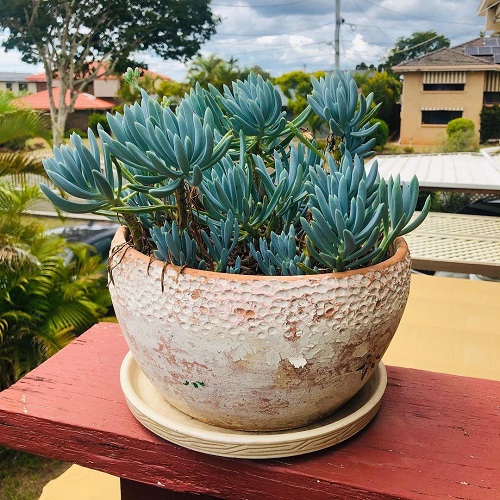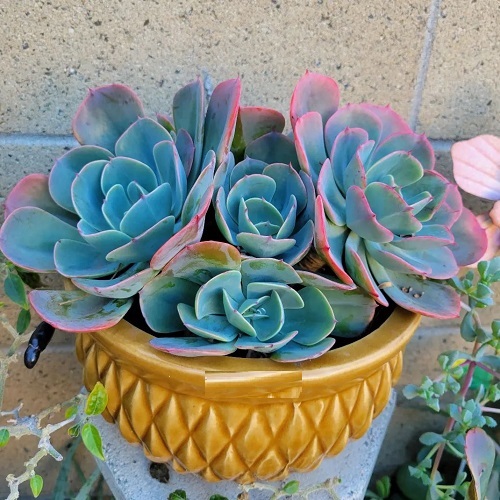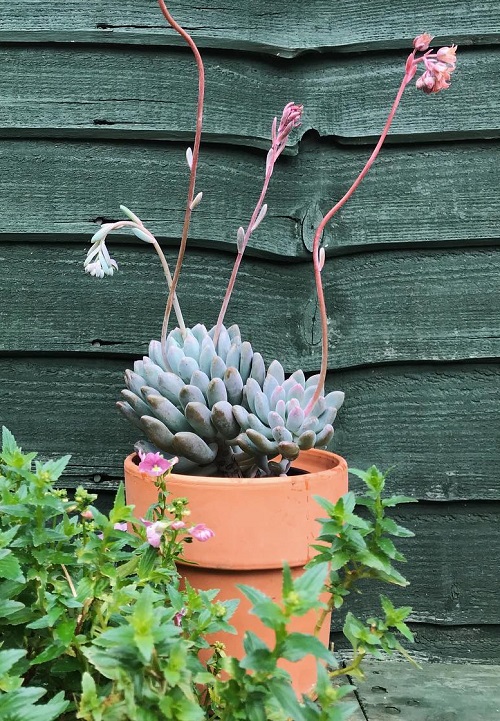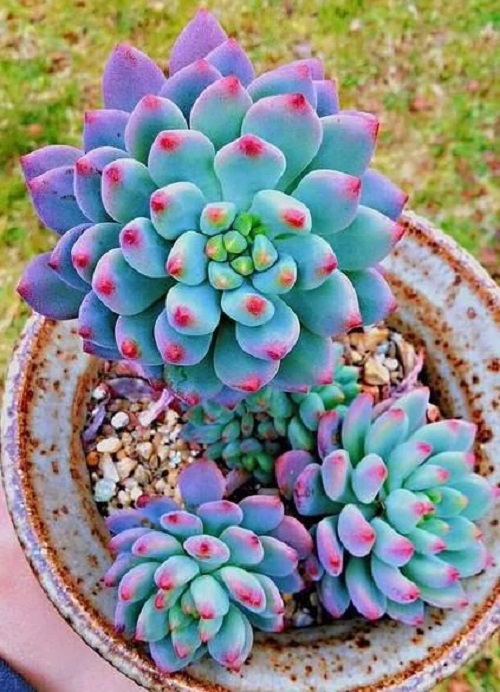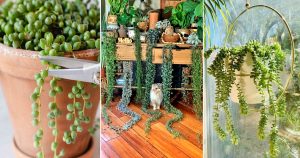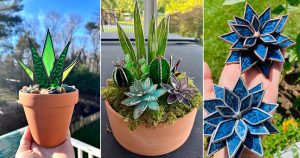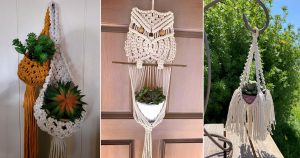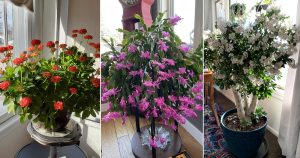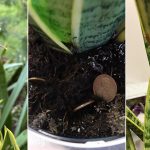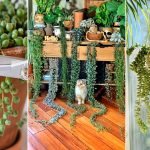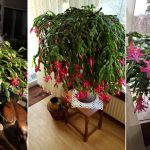This article will provide a list of the best blue succulents that will get rid of the blues in your plant collection!
According to surveys, blue is the most popular color in the world, however in the succulent world it is quite rare to spot, so get your hands on one of these blue succulents and gloat in front of your gardening buddies!
Best Blue Succulents
1. Sedum Major
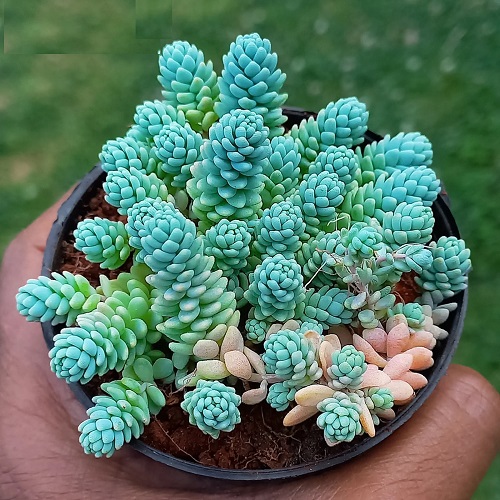
Botanical Name: Sedum ‘Major’
Also renowned as Corsican Stonecrop, this succulent will stand out in your plant collection due to its fleshy, bluish leaves that come in a rosette arrangement. These leaves are not just pretty to look at but also have a powdery feel to the touch. If the look and feel wasn’t enough, they also produce sweet smelling flowers, making it the complete package to beautify your indoors.
If you choose to grow this plant in a container, make sure the pot size is quite snug, filled with well-draining neutral to slightly alkaline soil. Ensure it is placed in a location where it is exposed to both full and partial sunlight like an east facing window.
2. Blue Chalksticks
Botanical Name: Senecio serpens
One look at this plant and you’ll be reminded of a bunch of blue-colored fingers growing in close proximity. Some view them as brightly colored pieces of chalk and hence the name. But in reality, these 1-2 inch long, peculiar shaped protrusions are actually the leaves of the succulent. Just like many others on this list they too have a powdery feel to them.
You can use this blue finger succulent as ground covers due to its ability to expand rapidly and retain its compact form. But remember to grow them in sandy, well-draining soil which is quite dry as this plant hates wet feet.
3. Blue Sky Echeveria
Botanical Name: Echeveria ‘Blue Sky’
The Blue Sky Echeveria is an artist’s dream due to the combo of multiple attractive colors. It is primarily blue but depending on the exposure to sunlight it might develop hot pink edges. The leaves have a farina coating that shields it from intense sunlight. It forms a beautiful rosette shape with thick, fleshy leaves and cute pink blooms that are equally as eye-catching.
4. Subsessilis Succulent
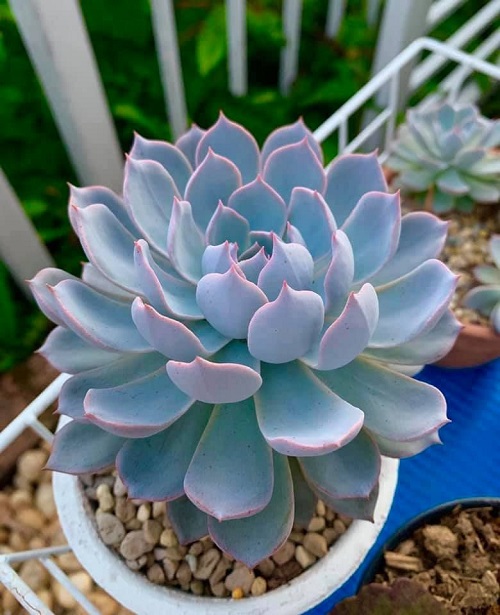
Botanical Name: Echeveria subsessilis
Despite looking like the variety above the Subsessilis Succulent is a completely different plant that displays the same physical traits. It too has spoon-shaped, fleshy leaves arranged in a rosette. The color palette is the same too, as the majority of the leaf is blueish gray while the edges are pink.
Just like other succulents, this plant is very drought tolerant and loves to bask in full sunlight, however that doesn’t mean it shouldn’t be watered at all. Create a watering schedule where you water the plant every time the top layer of the soil dries out completely.
5. Blue Candle Cactus
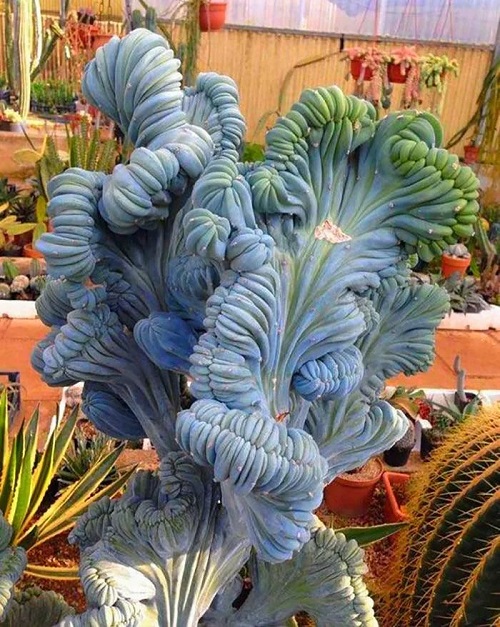
Botanical Name: Myrtillocactus geometrizans
If you choose to grow this plant, make sure you have some vertical space available as this blue cactus succulent can grow up to 5 meters tall. It’s not secret what color this plant is as the name gives it away, however the bright blue color is more pronounced when exposed to bright sunlight and in indoor conditions it would stay rather green. This branching succulent also produces fruits that are not only edible but also sought-after.
A Fact: The fruit of the Blue Candle Cactus is often called a ‘blueberry cactus’ fruit and is popular in Mexican cuisine.
6. Agave Butterfly
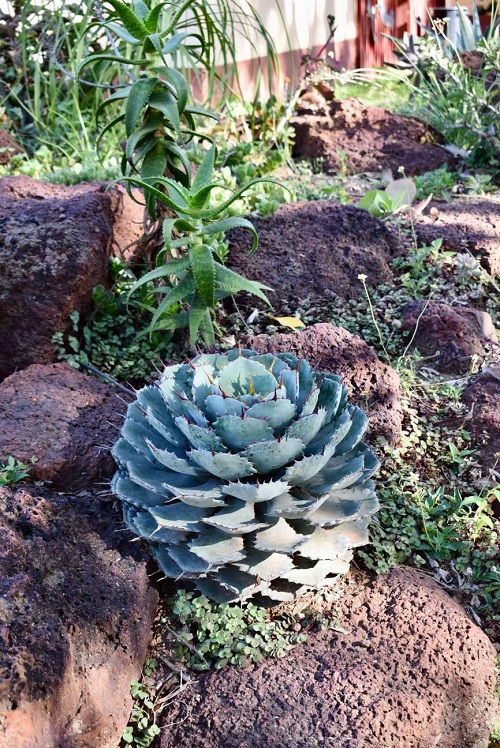
Botanical Name: Agave “Kissho Kan”
The Agave Butterfly is not as blue as others mentioned in this list, but it too shows off a shade of silvery-blue due to its powdery coating, which helps it manage heat and light. But beware—The attractive fleshy, broad, wavy leaves have sharp-toothed leaf margins and leaf spines that are reddish brown when mature, hence contrasting perfectly with the leaf color.
This plant performs well in various conditions, including acidic, neutral, and alkaline soil, loamy and sandy soil, and full and partial sunlight. So, it makes a perfect plant for novice landscapers looking to beautify their patio borders!
7. Echeveria ‘Blue Frills’
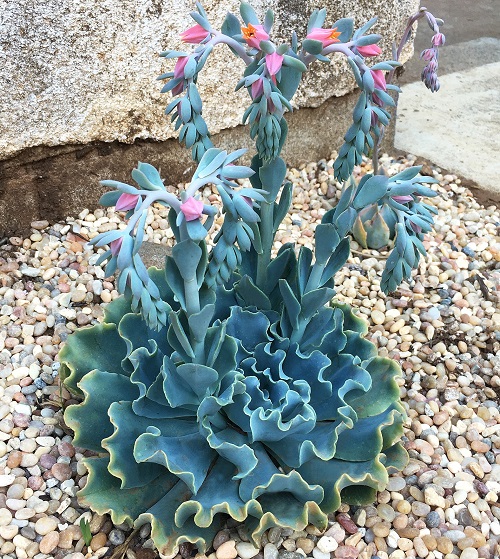
Botanical Name: Echeveria ‘Blue Frills’
This blue echeveria succulent is a member of the Crassulaceae family and steals the spotlight due to its blue-colored thick, waxy leaves that have frilled edges. At first glance, it may look like a leafy lettuce plant, but once you touch it, the differences become apparent. The frill becomes more prominent as the plant ages.
8. Echeveria ‘Cana’
Botanical Name: Echeveria cana
Don’t have a lot of space but want to incorporate a blue succulent? The Echeveria Cana is the plant for the job! This plant has a compact size with oblong, pebble-like leaves having a bluish hue. However if you provide it space it will grow a bit larger with vertical columns of neat rosette with slightly pointed and chunky leaves.
9. Happy Plant
Botanical Name: Sedeveria ‘Blue Elf’
Happy Plant will truly put a smile on your face due to its unique color palate and physical form. As a matter of fact this succulent is a genetically modified plant grown at Altman plants. It has a beautiful blue tint because of its sun-reflecting waxy, thick, chubby leaves that have a pinkish hue at the tips.
If you pay attention to the botanical name you will figure out that it is a hybrid of Sedum and Echeveria bringing the best of both worlds. Happy Plant requires a cozy pot filled with textured succulent potting mix that is well draining. It will thrive at the window pane of a south facing window but it can shift outside during the warmer months.
10. Blue Bean
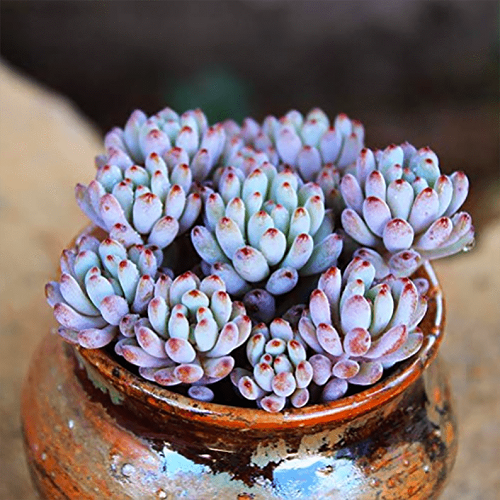
Botanical Name: Graptopetalum pachyphyllum Blue
Although it is usually not found in the bright blue color that its name suggests, the Blue Bean can portray a strong blue hue if given the right growing conditions like bright indoor light, sparse watering and well-draining coarse soil. It is no mystery as to why it is called bean or jelly bean plant as it possesses short, plump leaves that form dense clusters.
11. Hybrid Century Plant
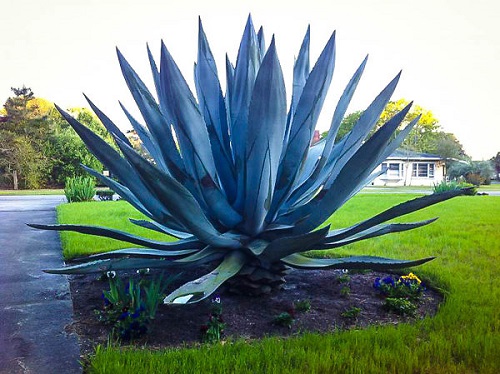
Botanical Name: Agave americana L.
The Hybrid Century Plant is a cross between two famous Century plant varieties: Agave ovatifolia and Agave flexispina. It stands out due to this large imposing size and bluish tint from its powdery surface. It grows large, thick leaves that are edged with spines that taper to a pointy pin at the top.
Note: This blue agave succulent is also popular for its impressive flowering stalk that can reach up to 40 feet in height.
Each of these Blue succulents are unique in your plant collection! Just give them the care they need, and they’ll thrive and bring you joy for years to come. So, what are you waiting for? Grab one of these blue beauties and share your experiences in the comments below! Have you already tried growing any of these? Do you have any tips or tricks to share? After all, a garden is a friend you can visit anytime, and sharing makes the experience all the richer.

